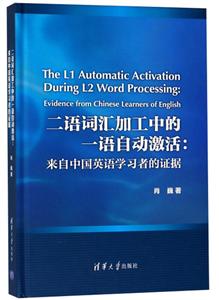二語匯加工中的一語激活來自中國英語學(xué)習(xí)者的證據(jù) 版權(quán)信息
- ISBN:9787302512684
- 條形碼:9787302512684 ; 978-7-302-51268-4
- 裝幀:一般膠版紙
- 冊(cè)數(shù):暫無
- 重量:暫無
- 所屬分類:>>
二語匯加工中的一語激活來自中國英語學(xué)習(xí)者的證據(jù) 本書特色
本書可供對(duì)詞匯加工與詞匯習(xí)得感興趣的研究生和科研人員閱讀參考
二語匯加工中的一語激活來自中國英語學(xué)習(xí)者的證據(jù) 內(nèi)容簡(jiǎn)介
詞匯知識(shí)是語言能力的核心組成部分,詞匯習(xí)得在二語習(xí)得研究中占據(jù)極其重要的地位。肖巍著的《二語詞匯加工中的一語自動(dòng)激活——來自中國英語學(xué)習(xí)者的證據(jù)(英文版)》結(jié)合反應(yīng)時(shí)技術(shù)和ERP技術(shù),通過語義相關(guān)判斷任務(wù)和掩蔽詞匯判斷任務(wù),探討了中國英語學(xué)習(xí)者在加工二語詞匯時(shí)的一語自動(dòng)激活規(guī)律特點(diǎn),并嘗試性地針對(duì)廣泛應(yīng)用于拼音文字的BIA+模型和RHM模型的特點(diǎn)與不足,構(gòu)建了能夠兼顧漢語特殊性的“擴(kuò)展層級(jí)模型”。 本書可供對(duì)詞匯加工與詞匯習(xí)得感興趣的研究生和科研人員閱讀參考。
二語匯加工中的一語激活來自中國英語學(xué)習(xí)者的證據(jù) 目錄
Preface
List of Abbreviations
Chapter One Introduction
Chapter Two Theoretical and Empirical Background
2.1 Definition of Key Terms
2.1.1 Bilinguals
2.1.2 Mental Lexicon
2.1.3 Lexical Representation
2.1.4 Lexical Processing
2.1.5 Lexical Automatic Activation
2.1.6 Priming
2.2 Theories on Mental Lexicon
2.3 Theoretical Models of Bilingual Lexical Processing
2.3.1 Bilingual Interactive Activation Model
2.3.2 Semantic, Orthographic and Phonological Interactive Activation Model
2.3.3 BIA+ Model
2.3.4 Weinrich's Model
2.3.5 Concept Mediation Model and Word Association Model
2.3.6 Revised Hierarchical Model
2.3.7 Distributed Concept Feature Model
2.3.8 Shared Asymmetrical Model
2.3.9 Modified Hierarchical Model
2.3.10 Three-Stage Model
2.3.11 Sense Model
2.3.12 Language Mode Hypothesis
2.3.13 Inhibitory Control Model
2.3.14 Summary of the Theoretical Models
2.4 The Empirical Studies on Bilingual Activation
2.4.1 Lexical Decision Task
2.4.2 Semantic Relatedness Judgment
2.4.3 Translation
2.4.4 Picture-Word Interference Task
2.4.5 Other Tasks
2.4.6 Limitations of the Previous Empirical Studies
2.4.6.1 Studies at the Sub-Lexical Level
2.4.6.2 Types of Bilinguals Investigated
2.4.6.3 Research Technique
2.4.6.4 Stimuli
2.4.6.5 Stimulus Onset Asynchrony (SOA)
2.5 Summary
Chapter Three Methodology
3.1 Research Questions
3.2 Overview of the Experiment Rationale and Design
3.2.1 Rationale
3.2.2 Design
3.3 Methods in Experiment 1
3.3.1 Participants
3.3.2 Experiment Design and Materials
3.3.3 Experiment Procedures
3.3.4 Data Recording and Analyses
二語匯加工中的一語激活來自中國英語學(xué)習(xí)者的證據(jù) 節(jié)選
Preface Vocabulary knowledge is a core component of language com-petence, and vocabulary acquisition plays a vital role in second language acquisition research. In recent years, with the integration with other disciplines such as psycholinguistics, neurolinguistics and cognitive sciences, vocabulary acquisition of second language has massively expanded its research field and has nurtured a series of new hot issues. One of them is the bilingual lexical automatic activation. Many studies have found out that L1 may be automatically activated during the processing of L2 words. By far, the research of L1 automatic activation in L2 word processing has made great progress, yet there are still some limitations. In terms of research participants, most studies take second language learners with alphabetic L1 as participants, but little attention has been paid to English learners in China with non-alphabetic L1. In terms of research content, there is still a lack of comprehensive and systematic exploration on the locus (conceptual level/lexical level/sub-lexical level) and time course of L1 automatic activation. Methodologically, most studies have only used the basic reaction time (RT) technique rather than the event-related potentials (ERP) technique, which has a high temporal resolution and is able to make a real time record of the cognitive processing. Besides, the cross-language tasks that have widely been used provide a bilingual context themselves and bias toward a dual-language activation pattern, which may lead to participants’ conscious rather than automatic activation of L1 and hence result in interference to the observation of L1 automatic activation. Theoretically, most of the theoretical models have been proposed based only on the studies on alphabetic languages. It needs verification whether or not these models can be applied to the ideographic languages such as Chinese, but little research has worked on it. Regarding these facts, the present study intends to investigate the L1 automatic activation during L2 word processing of the highly proficient and unbalanced Chinese-English bilinguals (Chinese learners of English), by combining RT technique and the ERP technique, and applying the semantic relatedness judgment task and masked lexical decision task. The research questions involve: (1) Where is the locus of L1 Chinese automatic activation during L2 English processing? That is, at which level or levels (conceptual level/ lexical level/sub-lexical level) does the activation take place? What is the difference in activation locus between the deep processing and shallow processing? (2) What characterizes the time course of L1 Chinese automatic activation during L2 English processing? That is, what are the features of the activation at the early and the late stages of L2 English processing respectively? What is the difference in activation time course between the deep processing and shallow processing? To answer these questions, two experiments have been carried out. Experiment 1 was a semantic relatedness judgment task. Twenty-one participants judged whether the prime words and the target words were semantically related. Experiment 2 was a masked lexical decision task. Fourteen participants judged whether the target words were real words. The core materials in the two experiments were the same 210 English word pairs. Half of them were semantically related while the other half were not. Although these English word pairs did not share any morphological repetition, their Chinese translation equivalents eventually concealed a hidden repetition of the first character, repetition of the second character or no repetition. Thus, the manipulation of the two variables came to a within-subject 2 (semantic relatedness: related vs. unrelated) × 3 (hidden character repetition: first character repetition vs. second character repetition vs. no repetition) factorial design. Based on this design, the semantic relatedness was manipulated to measure the L1 automatic activation at the conceptual level and the position of hidden character repetition was manipulated to measure the L1 automatic activation at the lexical and sub-lexical levels. The ERP components N400 and LPC were extracted to measure the L1 automatic activation at the early stages and the late stages respectively. The SOAs of the first and the second experiment were set 700ms and 67ms respectively, in order to investigate the L1 automatic activation in deep processing and shallow processing. Based on the analyses of the RT and ERP data, the following findings have been revealed: 1) In shallow processing, no semantic priming effect or hidden repetition priming effect was observed. However, in deep processing, there was a significant effect of semantic priming and hidden repetition priming when Chinese learners of English were processing L2 words. It indicated that L1 Chinese automatic activation took place at the conceptual level, lexical level and sub-lexical level. That is to say, L2 word processing was accompanied with multi-level L1 automatic activation. The results supported the predictions of hierarchical structure of bilingual mental lexicon in the BIA+ Model. Besides, the asymmetry of hidden character repetition effect at the sub-lexical level has been found out for the first time. That is to say, the effect of the hidden character priming of the second character was more salient than that of the first character, which indicated that the automatic activation of the second character was stronger than the first character.
- >
李白與唐代文化
- >
羅曼·羅蘭讀書隨筆-精裝
- >
有舍有得是人生
- >
月亮虎
- >
詩經(jīng)-先民的歌唱
- >
伊索寓言-世界文學(xué)名著典藏-全譯本
- >
名家?guī)阕x魯迅:朝花夕拾
- >
苦雨齋序跋文-周作人自編集

















